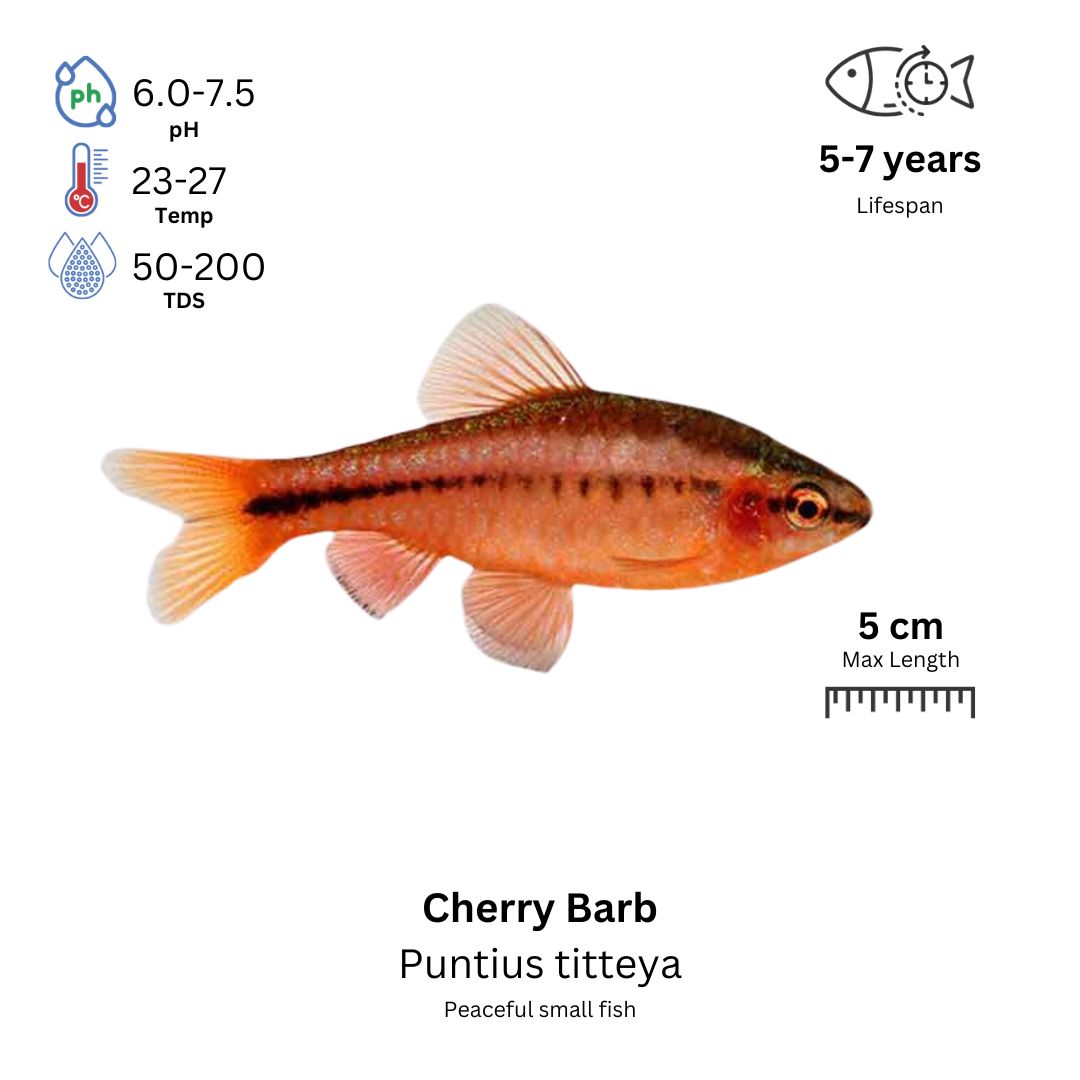Cherry Barb: Fish Species Profile
Species Overview
The Cherry Barb (Puntius titteya) is a small, vibrant freshwater fish renowned for its striking red coloration and peaceful demeanor. Native to Sri Lanka, this species is a popular choice among aquarists seeking an active and visually appealing addition to their community tanks.
- Common Names: Cherry Barb
- Scientific Name: Puntius titteya
- Adult Size: Up to 2 inches (5 cm)
- Life Expectancy: 4–7 years
Characteristics
- Family: Cyprinidae
- Origin: Sri Lanka
- Social: Peaceful schooling fish
- Tank Level: Mid to bottom water levels
- Minimum Tank Size: 25 gallons
- Diet: Omnivore
- Breeding: Egg layer
- Care Level: Easy
- pH: 6.0–7.0
- Hardness: 2–18 dGH
- Temperature: 74–79°F (23–26°C)
Origin and Distribution
Cherry Barbs are indigenous to the tropical river basins of Sri Lanka, particularly the Kelani and Nilwala rivers. These environments are characterized by shallow, warm waters with dense vegetation, providing ample hiding spots and feeding opportunities.
Colors and Markings
The Cherry Barb boasts a vibrant red hue, with males displaying more intense coloration, especially during breeding periods. Females are generally paler with a yellowish-grey back and a whitish abdomen. Both sexes feature a distinctive horizontal stripe running from the snout to the base of the tail.
Tankmates
Cherry Barbs are peaceful and thrive in community tanks with other non-aggressive species. Suitable tankmates include:
- Tetras
- Guppies
- Platies
- Mollies
- Swordtails
- Corydoras Catfish
- Otocinclus Catfish
Avoid housing them with larger, aggressive fish that may view them as prey.
Habitat and Care
To replicate their natural habitat:
- Tank Size: A minimum of 25 gallons is recommended to accommodate a small school and provide ample swimming space.
- Substrate: Use a dark substrate to enhance their coloration.
- Plants: Incorporate live plants such as Java Fern, Anubias, and floating species to provide cover and mimic their natural environment.
- Lighting: Moderate lighting is ideal to showcase their vibrant hues.
- Filtration: Ensure efficient filtration to maintain water quality, as they are sensitive to poor conditions.
Regular water changes and monitoring of parameters are essential to keep them healthy.
Diet and Feeding
Cherry Barbs are omnivorous and thrive on a varied diet. Offer them:
- High-quality flake or pellet food
- Live or frozen foods like bloodworms, brine shrimp, and daphnia
- Occasional vegetable matter such as blanched spinach or spirulina-based flakes
Feed them small amounts 2–3 times daily, ensuring they consume all the food within a few minutes.
Gender Differences
Males are typically more slender with brighter red coloration, while females are slightly larger with a rounder abdomen, especially when ready to spawn.
Breeding
Breeding Cherry Barbs in captivity is relatively straightforward:
- Breeding Tank: Set up a separate tank with soft, slightly acidic water and fine-leaved plants or spawning mops.
- Conditioning: Feed breeding pairs a high-protein diet of live and frozen foods to encourage spawning.
- Spawning: After spawning, remove adults to prevent them from eating the eggs.
Eggs typically hatch within 24–36 hours, and fry become free-swimming a few days later. Feed fry infusoria or commercially available fry food until they are large enough to accept baby brine shrimp.
Further Research
For more information on similar species and care techniques, consider exploring:
- Harlequin Rasbora
- Neon Tetra
- Ember Tetra
FAQ
How many Cherry Barbs should I keep together?
It’s best to keep them in groups of at least 6–8 individuals to reduce stress and encourage natural schooling behavior.
Are Cherry Barbs suitable for beginners?
Yes, their hardy nature and peaceful temperament make them suitable for novice aquarists.
What is the ideal tank setup for Cherry Barbs?
A well-planted tank with ample swimming space, moderate lighting, and stable water parameters closely mimics their natural habitat and helps them thrive.


Reviews
There are no reviews yet.